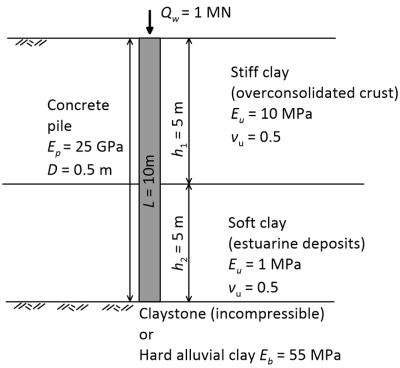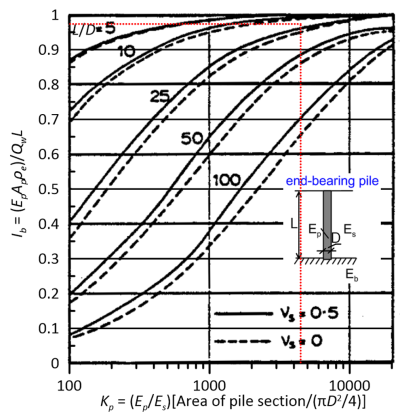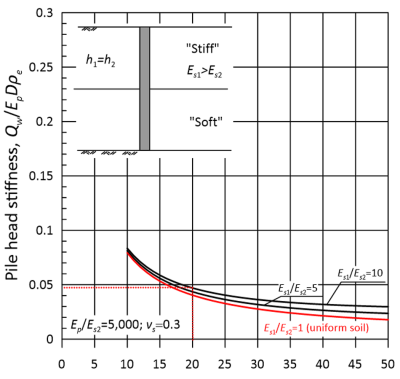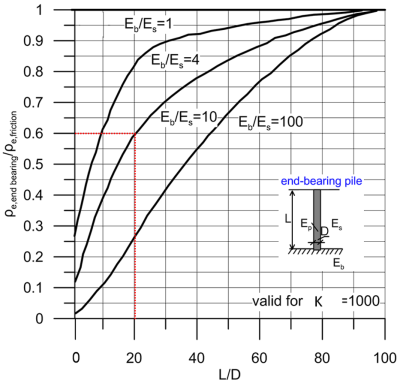Example 6.9
Calculation of settlement of an end-bearing pile in layered soil
Calculate the immediate settlement of the driven solid concrete pile shown in the Figure below, using i) the method of Poulos and Davis (1991) for end-bearing piles in uniform soil underlaid by rigid bedrock (claystone) and ii) the method of Zheng et al. (2023) for end-bearing piles in two-layered soil underlaid by rigid bedrock. Repeat the calculation, this time considering that instead of rigid claystone, the bedrock consists of hard alluvial clay with Eb = 55 MPa.

1. Calculation of settlement according to Poulos and Davis (1991) for Eb = inf:
We estimate the pile head stiffness factor Ib from Figure 6.71 using a weighted average soil modulus from Eq. 6.94 equal to Es = 5.5 MPa. For Kp = Ep/Es (solid pile) = 25,000/5.5 = 4,545 and L/D = 20 it is Ib ≈ 0.98 (see Figure below).

Therefore settlement of the end-bearing pile is equal to:
![]()

2. Calculation of settlement according to Zheng et al. (2024) for Eb = inf:
In lack of charts for soil Poisson’s ratio vs = 0.5, we will use the chart of Figure 6.74 to estimate the pile head stiffness Qw/EpDρe. Since here Ep/Es2 = 25,000 we will use the chart for the nearest Kp value of Kp= Ep/Es2 (solid pile) = 5,000 and Es1/Es2 = 10, L/D = 20. As shown below, we obtain Qw/EpDρe ≈ 0.048.

Therefore pile settlement is estimated to be:
![]()
This settlement value is lower to that computed with the method of Poulos and Davis, which requires using a weighted average soil modulus if the pile is driven in layered soil.
3. Calculation of settlement for hard alluvial clay bedrock (Eb = 55 MPa) :
We first consider the pile as friction pile, and obtain the factor Is from Figure 6.66. For Kp = Ep/Es (solid pile) = 25,000/5.5 = 4,545 and L/D = 20 it is Is ≈ 0.09.
Thus, from Eq. 6.95 it is:
![]()
We can now refer to Figure 6.72 and estimate the settlement of the end-bearing pile, as function of ρe,friction while considering pile slenderness L/D = 20 and Eb/Es = 55/5.5 = 10. Note that the particular figure presents results for Kp = 1000, therefore will provide an upper bound of settlement as here Kp = 4,545.

The above figure suggests that ρe,friction/ρe,end bearing = 0.6, therefore ρe = 0.6 × 32.7 = 19.6 mm.
It is clear from the above that: i) Considering a weighted average modulus may result in overestimating settlement when the surficial layer (crust) is stiffer than the bottom layer (soft soil), and ii) Assuming that the bedrock is incompressible can result in significantly underestimating settlement of relatively short piles (low L/D values), when the ratio of Young’s modulus of the bedrock over the Young’s modulus of the soil layer is Eb/Es = 10, or less.

